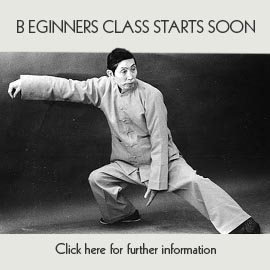Going nowhere and on the move:4 Principles of standing and 4 principles of moving steps in Tai Chi.
A basic premise of Tai Chi and infact even wider than that of life from a Chinese perspective is that if qi/energy is moving then it means whatever the organism is it is moving within: it must be alive. From a Chinese Medicine perspective if energy is moving healthily in the body we are alive and fit, if qi stops then health declines and eventually will whither.
It is famously stated in many areas within Tai Chi classical writings that there are several (traditionally 10) golden principles of aligning the body and keeping it open, so qi can smoothly flow through it unobstructed. However there are some clear and obvious points that relate to when the body is motionless and moving.
Imagine if you were a waiter carrying food to a customers table, or a parent carrying a child in your arms up the stairs. Your wish would be to keep the body balanced at both times of standing still and in movement to maintain control on what you are holding. This also applies if you want to hold the body open in a relaxed and unobstructed way. So to help with that there some key points to become aware of in your practice to help you hold an open and relaxed body at all times:
Structural alignment:
• Feet – Always sink the body weight through the centre of the feet.
• Waist – Sink the tailbone/Wei-Lu, imagine it hanging down so the lumbar vertebrae of the lower back don’t feel compressed.
• Chest/Back – Chest sunk and depressed, it feels soft and slightly sunk as if gently concaving back to the spine (but not obviously that far and not with physical force) – Back open and rounded, not by the use of force or strength but through gently opening between the shoulder blades.
• Neck-Occiput – Occiput (base of skull which joins onto the top of spinal column of neck) open by suspending the headtop and the chin very gently pushed back.
• Feet – as above
• No sinking before stepping. “Sung” or being sunk should always be present
• Keeping back leg loose to allow clear full and empty.
• Strong downward force through the full leg, when a leg is full for example a leg containing 70% of the body weight feel that you clearly and strongly sink downwards through it.
If you practice all 4 points whilst standing still and moving, your Tai Chi experience will quite quickly develop. Tai Chi depends upon our root or connectedness to the ground and by making good practice our natural habit. The “work” needed to get Tai Chi more correct and more refined becomes less and less. So by practising correct mobility and alignment in the body while still or moving, we can infact deal with several issues in one go and can find that there are several benefits:
• More relaxed state in and out of all movement.
• Better connection and stability through the legs.
• Improved circulation through the leg muscles and waist.
And most importantly:
• An accumulating experience of feeling qi in the body.
(Phil Vickery 2011)

